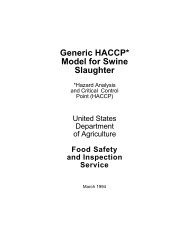Generic HACCP Model for Thermally Processed Commercial
Generic HACCP Model for Thermally Processed Commercial
Generic HACCP Model for Thermally Processed Commercial
Create successful ePaper yourself
Turn your PDF publications into a flip-book with our unique Google optimized e-Paper software.
hazards have been addressed.<br />
Critical Control Point (CCP) Determination: Identification and description of the CCP<br />
<strong>for</strong> each identified hazard is the next step in plan development. The CCP determination<br />
and the in<strong>for</strong>mation and data you recorded on the Hazard Analysis/Preventive Measures<br />
<strong>for</strong>m will be needed <strong>for</strong> completion of this portion of the plan.<br />
<strong>HACCP</strong> Plan Development: This portion of the plan development will be used to<br />
designate the specific activities, frequencies, critical limits, and corrective actions that<br />
ensure that your process is under control and adequate to produce a safe product. This<br />
part will include all the in<strong>for</strong>mation gathered to this point in your plan development<br />
process steps. In addition, the <strong>HACCP</strong> plan will include specification of critical limits.<br />
These limits will be specified after the identification of the CCP's <strong>for</strong> the process and will<br />
be listed in the <strong>HACCP</strong> Plan. The critical limit must, at a minimum, meet the regulatory<br />
requirement <strong>for</strong> that specific process step if one exists. An equivalent limit based on a<br />
process or technology proven to render the product unadulterated may also be used.<br />
The following will be identified or described in the <strong>HACCP</strong> plan: the establishment<br />
monitoring procedure or device to be used; the corrective action to be taken if the limit is<br />
exceeded; the individual responsible <strong>for</strong> taking corrective action; the records that will be<br />
generated and maintained <strong>for</strong> each CCP; and the establishment verification activities and the<br />
frequency at which they will be conducted.<br />
A copy of the Decision Tree developed by the NACMCF is included at the end of this<br />
section. The use of the Decision Tree is optional. The questions in the Decision Tree are listed<br />
at the top of each page of the CCP Determination <strong>for</strong>m of the generic model. These questions<br />
should be answered when identifying critical control points <strong>for</strong> your <strong>HACCP</strong> plan. Remember<br />
that the <strong>HACCP</strong> plan should cover health and safety CCP's, not economic and quality concerns.<br />
A CCP should be identified when it presents a significant hazard and has a significant likelihood<br />
of occurrence. Hazards that are unlikely to occur or do not present significant hazards will not<br />
be considered during Hazard Analysis and, there<strong>for</strong>e, will not be identified as a CCP.<br />
Remember that <strong>HACCP</strong> is a system of process control <strong>for</strong> the plant and not an inspection<br />
system. The creation of the plant-specific plan and its successful operation is the responsibility<br />
of each establishment. The plant-specific plan that you have developed will be used to help you<br />
monitor your process. The plan should be reassessed routinely by the plant to determine if<br />
updates are needed. Such cases may include, but are not limited to changes in: the types products<br />
produced; a process such as in raw materials or their source; product <strong>for</strong>mulation; processing or<br />
slaughter methods or systems; production volume; packaging; finished product distribution<br />
systems; the intended use or consumers of the finished product; or it is determined that the plan<br />
does not adequately ensure process control, defined as when critical limits are not being met.<br />
Revision of the <strong>HACCP</strong> plan should be conducted with the advice and assistance of an individual<br />
trained to meet the requirement in 9CFR 417.7.<br />
5



